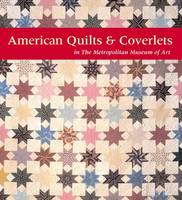


|
|
| book details |
American Quilts and Coverlets in The Metropolitan Museum of Art
By (author) Amelia Peck, Other primary creator Cynthia V. A. Schaffner, Other primary creator Elena Phipps

|
This book is currently unavailable. Enquire to check if we can source a used copy
|
| book description |
Newly Available from Yale This handsome book showcases the Metropolitan Museum's superb collection of 151 American quilts and coverlets. First published in 1990 and revised in 2007 to feature 32 new acquisitions and updated scholarship, this volume chronicles the development of quilt and coverlet production in the United States from the 18th through the 20th centuries, provides a glimpse into the lives of the makers and recipients of these pieces, and discusses their emergence as works of art. Notable pieces include the Phebe Warner and the Baltimore Presentation coverlets, Amish, Crazy, and Honeycomb quilts that exemplify achievement in abstract and geometric patterns, along with the Adeline Harris Sears Autograph Quilt, a memorial to the greatest politicians, composers, authors, and thinkers of the mid-19th century. Each work is catalogued with a description and essential information on materials, condition, publications, and references. Also included is an illustrated survey of materials and techniques used in the creation of these works.
| product details |
Normally shipped |
Publisher | Yale University Press
Published date | 7 Jul 2009
Language |
Format | Hardback
Pages | 320
Dimensions | 279 x 254 x 0mm (L x W x H)
Weight | 2109g
ISBN | 978-0-3001-5903-5
Readership Age |
BISAC | antiques & collectibles / textiles & costume
| other options |
|
|
|
To view the items in your trolley please sign in.
| sign in |
|
|
|
| specials |
|
|
Let's stare the future down and, instead of fearing AI, become solutionists.
|
This first comprehensive biography of Cecil Rhodes in a generation illuminates Rhodes’s vision for the expansion of imperialism in southern Africa, connecting politics and industry to internal development, and examines how this fueled a lasting, white-dominated colonial society.
|
|
|
|
|